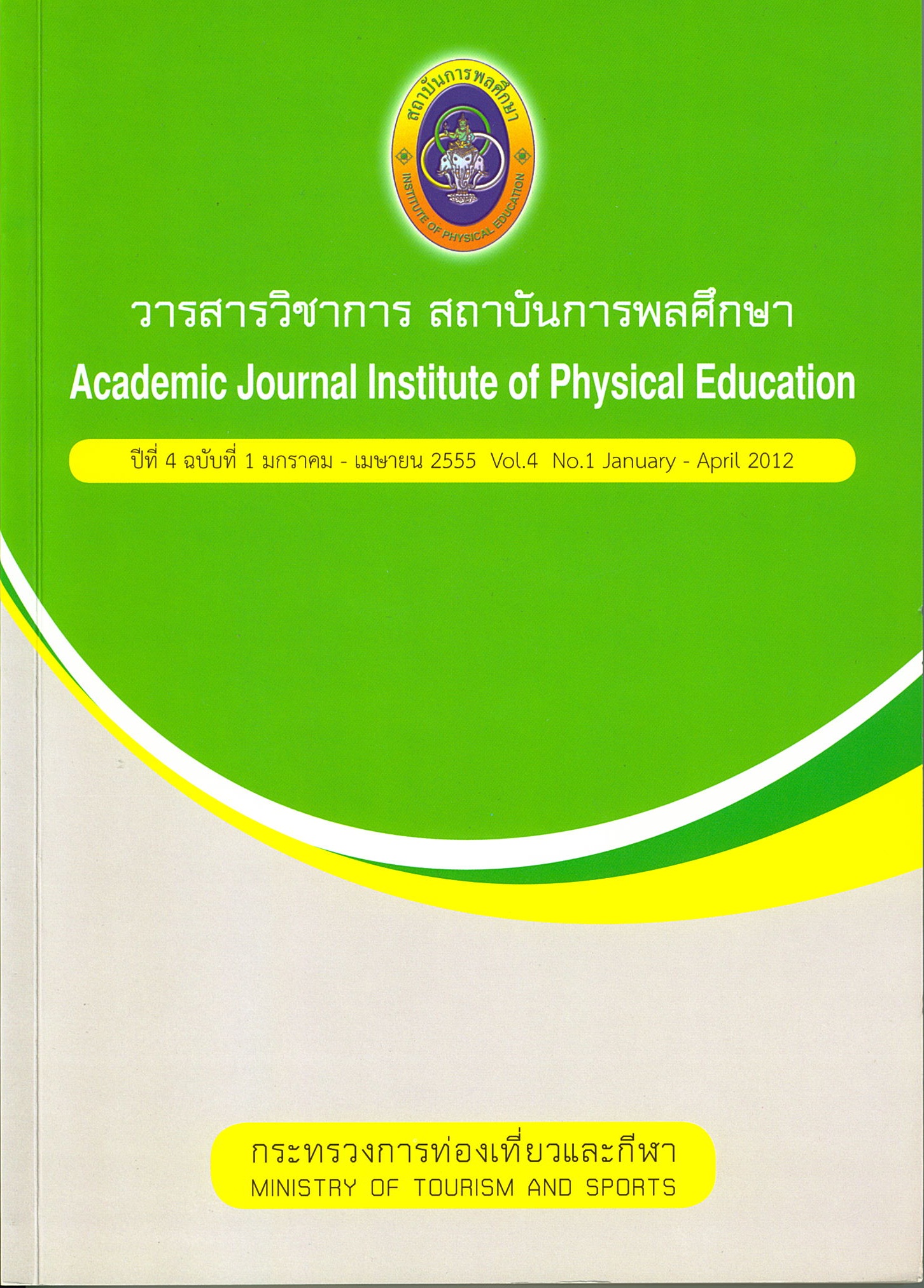The Development of Indicators For Volleyball Talent in Male Players Undet The Age of Eighteen
Main Article Content
Abstract
In this research investigation, the researcher develops (1) indicators for volleyball talent in male players under the age of eighteen. The researcher thereupon conducts (2) an efficiency test for validating the indicator test based on the indicators as given to the players under study. Finally, the researcher develops (3) standardized criteria applicable to male players under the age of eighteen who are members of the national team and corresponding standardized criteria for male players at large who are under the age eighteen through applying the investigatory results of the validated indicator test for volleyball talent developed by the researcher.
The research for this investigation unfolded in four consecutive steps as follows: (1) Research was conducted so as to develop indicators for volleyball talent in male players under the age of eighteen.(2) The instrument of research was then constructed. (3) The quality of the instrument of research was subsequently established. Finally, (4) the standardized criteria for both groups of players were determined.
The sample population consisted of 252 male volleyball players under the age of eighteen divided in accordance with three levels of ability.
Research findings show that there were four indicators for volleyball talent in the sample population of male volleyball players under the age of eighteen. These four indicators involved (1) physiology; (2) volleyball skills; (3) psychology; and (4) the learning of motor skills.
The instrument of research was the test of indicators showing volleyball talent for the members of the sample population. The content validity of the instrument of research was determined to be at the level of 0.78. Furthermore, its construct validity was also found to be at the statistically significant level of .05 for all test programs. There were two norm-referenced standardized criteria: one for the players belonging to the
national team and one for the players at large. In addition, established were the criteria for determining levels of ability as ascertained by the total scores on the test for talent indicators in the aforementioned four aspects. Subsequently, the researcher divided ability into five levels, viz., very good, good, moderate, low, and very low.
It can be concluded that the test of indicators for volleyball talent on the part of male players under the age of eighteen can be used as a field test for indicating the volleyball talent of the players belonging to this age group in all four aspects. The contents of the instrument of research have been shown to evince a high level of validity. Testing of its construct validity has also shown that it can be used to classify volleyball players having talent in contradistinction to ordinary volleyball players. In regard to validity, there were standardized criteria for the T-score results whereby raw scores were transformed into standard form. Furthermore, standardized norms for establishing levels of ability were also developed. A manual was additionally drawn up and can be used for assessment. In addition, the researcher provided testing details that can be consulted by those interested in using these testing procedures in the future for screening volleyball players so as to determine those who have talent and the level at which their talent is expressed
Article Details
The published article is a copyright of the Academic Journal of Thailand National Sports University. The passage appeared in each article in this academic journal is a perspective of each author which is not related to the journal. Each author is required to be responsible for all components of his/her own article. If there are any mistakes, each author must be responsible for those mistakes on his/her own.
References
บุญเรียง ขจรศิลป์. วิธีวิจัยทางการศึกษา. (พิมพ์ครั้งที่ 4), กรุงเทพมหานคร: พี.เอ็น. การพิมพ์, 2539.
ผาณิต บิลมาศ. การทดสอบและการประเมินผลพลศึกษา, ภาควิชาพลศึกษา คณะพลศึกษา มหาวิทยาลัยศรีนครินทรวิโรฒ, 2530.
วรรณี แกมเกตุ. รายงานการวิจัยเรื่อง การพัฒนาตัวบ่งชี้ความสามารถในการพึ่งตนเองของครอบครัวและชุมชน สํานักงานคณะกรรมการส่งเสริมการวิจัยแห่งชาติ, 2546.
ศิริชัย กาญจนวาสี, ทฤษฎีการประเมิน (พิมพ์ครั้งที่ 2), กรุงเทพมหานคร: สํานักพิมพ์แห่งจุฬาลงกรณ์มหาวิทยาลัย, 2544.
สุพิตร สมาหิโต. หลักและวิธีสอนพลศึกษา ภาควิชาพลศึกษา คณะศึกษาศาสตร์ มหาวิทยาลัย เกษตรศาสตร์, 2530.
Garrett, H.E. Statistics in psychology and education. New York: McKay, 1966.
Kerlinger, F.N. Foundations of behavioral research. (3rd Edition). New York: Holt, Rinehart and Winston, 1986.
Thomson, R.W. and Beavis, N. Talent Identification and development in soccer. Report on behalf of the Otago University and Community Sports Trust for the New Zealand Sports Foundation Inc. and the Ministry of Recreation and Sport, 1. Wellington: The New Zealand Sports Foundation Inc, 1985.
เทิดพระเกียรติพระบาทสมเด็จพระเจ้าอยู่หัวกับการกีฬา Retrieved July 20, 2011, from http://www.supermot.au.edu/kingl.html
การเสวนาเรื่อง การทบทวนและประเมินผลแผนพัฒนาการกีฬาแห่งชาติ ฉบับที่ 4 Retrieved July 20,
, from http://secretary.mots.go.th/ewt_news.php?nid=2354&filename=ict)
Women's Volleyball Recruiting Guidelines. Retrieved July 20, 2011, from
http://www.ncsasports.org/recruiting-tools/College-Volleyball-Recruiting/womens
volleyball-recruiting-guidelines American Beach Volleyball Players. Retrieved July 20, 2011, from
http://www.volleyballadvisors.com/beach-volleyball-players.html

